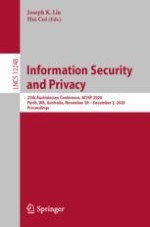This book constitutes the refereed proceedings of the 25th Australasian Conference on Information Security and Privacy, ACISP 2020, held in Perth, WA, Australia, in November 2020*.
The 31 revised full papers and 5 short papers presented were carefully revised and selected from 151 submissions. The papers present and discuss the latest research, trends, breakthroughs, and challenges in the domain of information security, privacy and cybersecurity on a variety of topics such as post-quantum cryptography; symmetric cipher; signature; network security and blockchain; cryptographic primitives; mathematical foundation; machine learning security, among others.
*The conference was held virtually due to COVID-19 pandemic.
